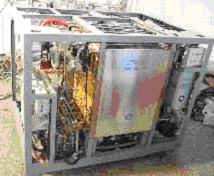
The fuel cell is an energy conversion device, in which the energy stored in fuel and oxidant is transformed into electricity and heat energy via electrochemical reactions. It has the advantage of high energy transform efficiency, low noise, environmental friendliness. It can also achieve energy supply diversity.
The Chinese government attaches much importance to fuel cell technologies. In January 2002, a key project on "Electric Vehicle" (EV) was initiated in the high-tech sector of National "863 program". The fuel cell powered vehicle is one of main research topics of the project. In addition, CAS launched a key project on high power PEMFC (Proton Exchange Membrane Fuel Cell) engine and hydrogen technology in its Knowledge Innovation Program (KIP).
In October 2001, a project titled "High Power PEMFC Engine and Hydrogen Technology" was officially initiated as a key project of the CAS KIP Project. The CAS Dalian Institute of Chemical Physics (DICP) is the presiding institute of the project, and Prof. Zhang Huamin and Prof. Yi Baolian from DICP was appointed the project leader and the chief scientist, respectively. Other main participating institutions include Zhejiang University, the CAS Institute of Electric Engineering (IEE) in Beijing, the CAS Institute of Micro-system & Information Technology (IMIT) in Shanghai, and Dalian Sunrise Power Co. Ltd. DICP is responsible for the research and development of fuel cell stacks and fuel cell key components, the control logic and strategy design of fuel cell engine (FCE), the system design and integration of FCE and FCE’s fuel supply -- the methanol reforming hydrogen production system. Zhejiang University is designated to develop air compressor for FCE. IMIT is commissioned to develop the metal hydrogen storage system. And IEE is assigned to develop the DC/DC converter. The main targets of this project are: to develop, in three years, three types of FCE, namely 75 kW H2/Air FCE, 75 kW methanol reforming gas/air FCE and 150 kW H2/Air FCE, and two types of fuel sources, namely 75 kW methanol reforming system and metal hydrogen storage system; and with a backup fuel source -- high pressurized hydrogen, to achieve the systematic integration of FCE and hydrogen source.
After more than two years' research and development, the project has made significant progress, through the joint efforts of scientists and engineers, regarding fuel cell stack key materials and technologies, key parts and components in the subsystems of the engine and system integration of FCE.
“We will continue to improve the reliability, durability and practicability of FCE, develop the mass production technology of FCE key materials and key components, conduct demonstration of hydrogen and fuel cell technology, promote the fuel cell education and facilitate the practicability and industrialization of fuel cell technology,’ said Prof. Zhang Huamin, director of the Project.





